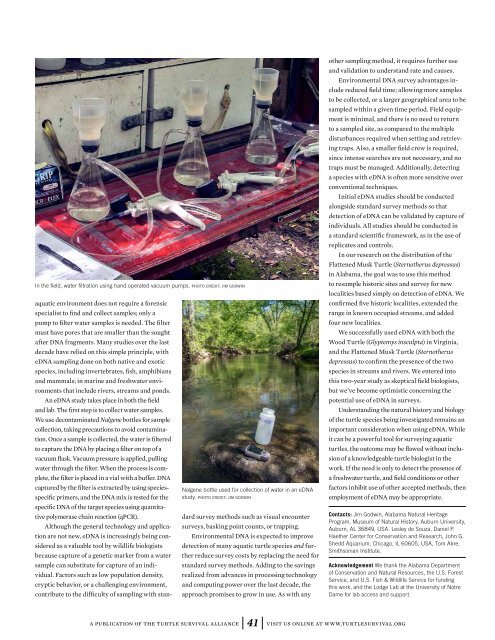Turtle Survival
2tUaeTbNi
2tUaeTbNi
You also want an ePaper? Increase the reach of your titles
YUMPU automatically turns print PDFs into web optimized ePapers that Google loves.
In the field, water filtration using hand operated vacuum pumps. PHOTO CREDIT: JIM GODWIN<br />
Nalgene bottle used for collection of water in an eDNA<br />
study. PHOTO CREDIT: JIM GODWIN<br />
aquatic environment does not require a forensic<br />
specialist to find and collect samples; only a<br />
pump to filter water samples is needed. The filter<br />
must have pores that are smaller than the sought<br />
after DNA fragments. Many studies over the last<br />
decade have relied on this simple principle, with<br />
eDNA sampling done on both native and exotic<br />
species, including invertebrates, fish, amphibians<br />
and mammals; in marine and freshwater environments<br />
that include rivers, streams and ponds.<br />
An eDNA study takes place in both the field<br />
and lab. The first step is to collect water samples.<br />
We use decontaminated Nalgene bottles for sample<br />
collection, taking precautions to avoid contamination.<br />
Once a sample is collected, the water is filtered<br />
to capture the DNA by placing a filter on top of a<br />
vacuum flask. Vacuum pressure is applied, pulling<br />
water through the filter. When the process is complete,<br />
the filter is placed in a vial with a buffer. DNA<br />
captured by the filter is extracted by using speciesspecific<br />
primers, and the DNA mix is tested for the<br />
specific DNA of the target species using quantitative<br />
polymerase chain reaction (qPCR).<br />
Although the general technology and application<br />
are not new, eDNA is increasingly being considered<br />
as a valuable tool by wildlife biologists<br />
because capture of a genetic marker from a water<br />
sample can substitute for capture of an individual.<br />
Factors such as low population density,<br />
cryptic behavior, or a challenging environment,<br />
contribute to the difficulty of sampling with standard<br />
survey methods such as visual encounter<br />
surveys, basking point counts, or trapping.<br />
Environmental DNA is expected to improve<br />
detection of many aquatic turtle species and further<br />
reduce survey costs by replacing the need for<br />
standard survey methods. Adding to the savings<br />
realized from advances in processing technology<br />
and computing power over the last decade, the<br />
approach promises to grow in use. As with any<br />
other sampling method, it requires further use<br />
and validation to understand rate and causes.<br />
Environmental DNA survey advantages include<br />
reduced field time; allowing more samples<br />
to be collected, or a larger geographical area to be<br />
sampled within a given time period. Field equipment<br />
is minimal, and there is no need to return<br />
to a sampled site, as compared to the multiple<br />
disturbances required when setting and retrieving<br />
traps. Also, a smaller field crew is required,<br />
since intense searches are not necessary, and no<br />
traps must be managed. Additionally, detecting<br />
a species with eDNA is often more sensitive over<br />
conventional techniques.<br />
Initial eDNA studies should be conducted<br />
alongside standard survey methods so that<br />
detection of eDNA can be validated by capture of<br />
individuals. All studies should be conducted in<br />
a standard scientific framework, as in the use of<br />
replicates and controls.<br />
In our research on the distribution of the<br />
Flattened Musk <strong>Turtle</strong> (Sternotherus depressus)<br />
in Alabama, the goal was to use this method<br />
to resample historic sites and survey for new<br />
localities based simply on detection of eDNA. We<br />
confirmed five historic localities, extended the<br />
range in known occupied streams, and added<br />
four new localities.<br />
We successfully used eDNA with both the<br />
Wood <strong>Turtle</strong> (Glyptemys insculpta) in Virginia,<br />
and the Flattened Musk <strong>Turtle</strong> (Sternotherus<br />
depressus) to confirm the presence of the two<br />
species in streams and rivers. We entered into<br />
this two-year study as skeptical field biologists,<br />
but we’ve become optimistic concerning the<br />
potential use of eDNA in surveys.<br />
Understanding the natural history and biology<br />
of the turtle species being investigated remains an<br />
important consideration when using eDNA. While<br />
it can be a powerful tool for surveying aquatic<br />
turtles, the outcome may be flawed without inclusion<br />
of a knowledgeable turtle biologist in the<br />
work. If the need is only to detect the presence of<br />
a freshwater turtle, and field conditions or other<br />
factors inhibit use of other accepted methods, then<br />
employment of eDNA may be appropriate.<br />
Contacts: Jim Godwin, Alabama Natural Heritage<br />
Program, Museum of Natural History, Auburn University,<br />
Auburn, AL 36849, USA. Lesley de Souza, Daniel P.<br />
Haether Center for Conservation and Research, John G.<br />
Shedd Aquarium, Chicago, IL 60605, USA, Tom Akre,<br />
Smithsonian Institute.<br />
Acknowledgement We thank the Alabama Department<br />
of Conservation and Natural Resources, the U.S. Forest<br />
Service, and U.S. Fish & Wildlife Service for funding<br />
this work, and the Lodge Lab at the University of Notre<br />
Dame for lab access and support.<br />
a publication of the turtle survival alliance 41 visit us online at www.turtlesurvival.org


